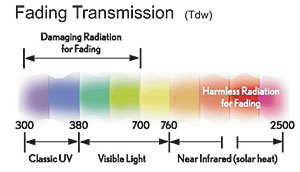Building Green with Windows and Doors
*Visible Transmittance (VT) measures how much visible light comes through a window and into a building by comparing the visible light that would pass through an open hole in the wall the same size as the window or door. A VT value of 60 percent or more appears clear to most people while a VT value below 50 percent begins to look dark and/or reflective.
Although the frame does not transmit visible light, it is included in calculating the overall VT measurement or rating. VT measurements vary between 0 and 1, with most values between .30 and .80.
Thehigher the VT, the more light is transmitted. Coatings and tints that block the Solar Heat Gain Coefficient will reduce the amount of visible light that passes through a window. It is therefore important to take VT into consideration when choosing a type of glass.
A low VT can lead to an increase in the amount of artificial light needed in a building, therefore increasing energy costs. Visible Transmittance is becoming an important number given the proven benefits of natural light for people, especially those seeking to reduce cases of Seasonal Affective Disorder Syndrome, a depression caused in the winter months when natural light is available for a short number of hours each day.
*Fading transmission relates to the interior furnishings of a building that can fade over time when certain parts of the solar spectrum enter a room. These include energy in the spectral region of 300 to 700 nanometers, or all of the ultra violet energy and most of the visible spectrum. Damage Weighted Transmittance, or Fading Transmission (Tdw), measures the amount of fading-causing solar energy that enters through a window. The lower the Tdw value, the better the glass protects against fading.
|
*Condensation Resistance (CR) measures how well a product resists the formation of condensation, which can be caused by a number of factors such as the humidity in the room or by the difference in temperatures between the interior and the exterior. CR is expressed as a number between 1 and 100 although most are limited to ratings of no higher than 70. The higher the number, the better a product is able to resist condensation. CR is an optional rating and manufacturers can choose not to include it on their labels.










